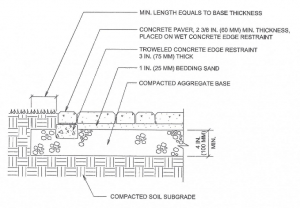If you are planning to have Orlando pavers installed, or you would like to DIY the pavers yourself, there are several steps in the  installation process you need to know. Here we will go over three important steps you need to complete for a good paver installation.
installation process you need to know. Here we will go over three important steps you need to complete for a good paver installation.
1. Excavation
Establish where you want the top surface of the Orlando pavers to be when installation is complete.
Place stakes around the parameter and mark stakes with the slope required to keep water running away from your house or building and top surface of the pavers. Place a string tightly on the stakes, to indicate the height and level to follow.
Calculate the total depth of excavation needed. Do this by adding together the inches required for the base (4 to 6 inches) the sand bedding (1 inch) and the paver thickness (usually 2 3/8”). This gives you the total depth needed to excavate. Dig out to the indicated depth, level and compact the ground with a power driven plate compacting tamper.
2. Base Material
With excavation completed it is now time to install the base material.
A good base is essential to having a good finished paver project. Base material consists of crushed rock or concrete. Limestone fines or Concrete fines are both excellent base materials. Both are easily compacted with a power driven plate compacting tamper. A properly installed base is critical to the long term success of your paver project.
Bedrock Orlando recommends at least 4” of base material. The best installation of the base is to put in about 2-3” of base material then compact with a power driven plate compacting tamper. Put in the final 2-3” of base material and compact again. When complete you want 4” of compacted base material. This will provide a stable long term base for your paver project. Make sure the compacted base is sloped to the grade you established.
3. Sand Bed
Before installing the Orlando pavers, a layer of bedding sand is placed over the compacted base material. This layer provides a bed into which the pavers are set. The sand bedding also helps to protect the sand joints from being eroded away.
Lay down two pieces of one inch diameter PVC pipe on the compacted base material. This needs to be done at the edges of your paving are but no more than about 6 feet apart. Spread a layer of sand about 1 ½” inches thick between the two PVC pipes. Place a 2 x 4 on top of the PVC pipe to use as a screed board across the sand. Screed the sand down so the PVC pipes are visible. Carefully remove the PVC pipe. This process ensures a uniform layer of sand one inch thick to use as a leveling bed.